7 Best Types of Rice for Your Health, Ranked by a Dietitian
Medically reviewed by Elizabeth Barnes, RDN
Rice, a staple food for over half the world's population, thrives in more than 100 countries and, along with wheat and maize (corn), provides 40% of all human calories. Abundant in carbohydrates, the body's primary energy source, rice encompasses over 110,000 cultivated varieties, varying in nutrition content and quality.
Certain types of rice may offer more nutritional benefits such as more fiber, protein, and even more antioxidants. Here's a list of the healthiest rice varieties to incorporate into your diet, plus tips for incorporating rice into a healthy eating plan.
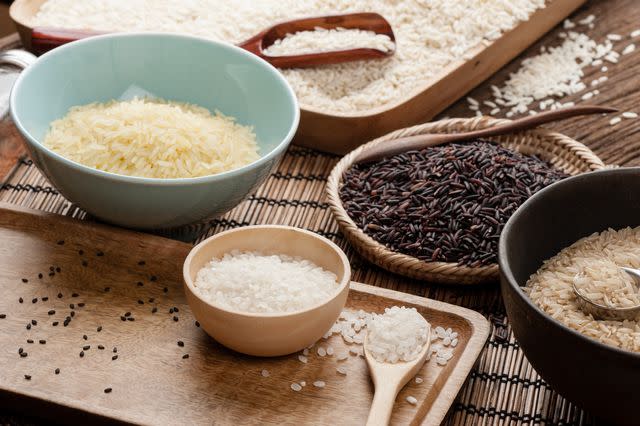
NorGal / Getty Images
1. Brown Rice
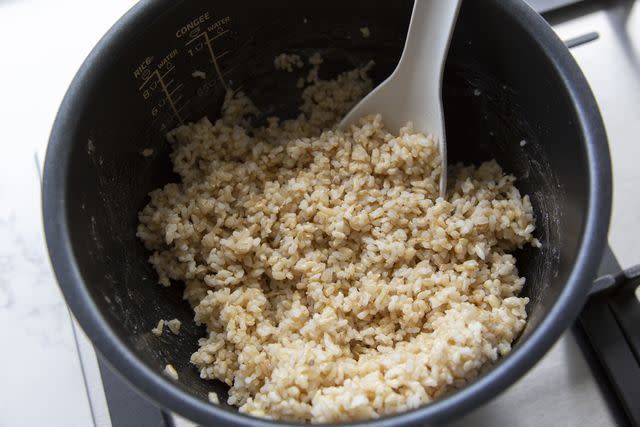
Jennifer A Smith / Getty Images
Brown rice is a whole grain variety distinguished by its unrefined nature, comprising the entire grain kernel. Unlike refined grains, which retain the starchy endosperm and are stripped of their nutrient-rich components, brown rice retains the germ and the bran layers.
The bran, the grain's outer layer, boasts antioxidants, B vitamins, and fiber. Meanwhile, the germ, or embryo, houses B vitamins, healthy fats, minerals, and some protein.
The Dietary Guidelines suggest that half of our grain intake should consist of whole grains. Beyond their abundant nutrient content, incorporating whole grains into a balanced diet promotes healthy digestion and may reduce the risk of heart disease while aiding in weight management efforts.
One cup of cooked long-grain brown rice provides 248 calories, 5.54 grams of protein, 51.7 grams of carbs, and 3.23 grams of fiber.
2. Black Rice
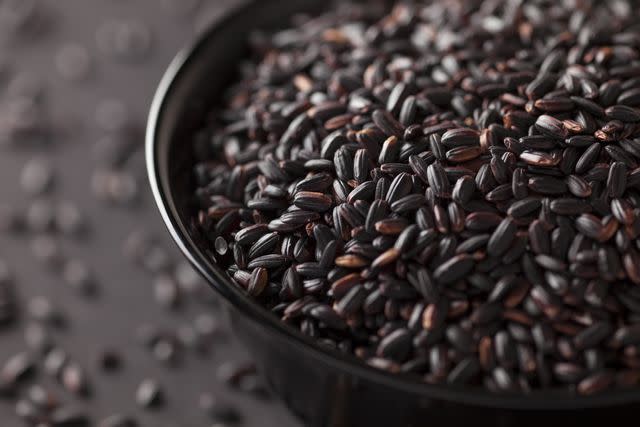
Professor25 / Getty Images
Whole grain rice offers other colors beyond the brown rice variety, such as black rice and red rice. Black rice has earned the moniker "forbidden rice" owing to historical tales of its scarcity, which led an emperor to restrict its consumption, reserving it exclusively for himself.
Originating in Japan, black rice gets its deep purplish-black hue from its abundant anthocyanin content. Anthocyanins are a type of antioxidant present in vibrant-colored foods such as blueberries and red cabbage.
Antioxidants play a crucial role in shielding against cardiovascular disease and cancer. Research shows that black rice surpasses brown, red, and purple rice in antioxidant activity.
A two-thirds cup serving of dry long-grain black rice provides 170 calories, 4 grams of protein, 39 grams of carbs, and 2 grams of fiber.
3. Red Rice
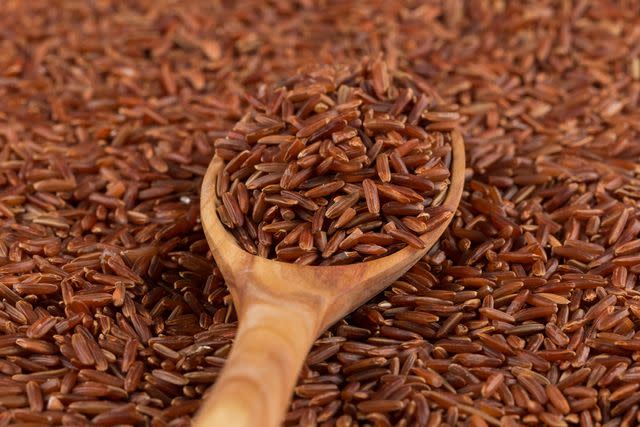
R.Tsubin / Getty Images
Known for its nutty taste and fragrant aroma, red rice mainly grows in Thailand, Bhutan, and the Camargue region of southern France. It's also grown in California's Sacramento Valley. Like other pigmented rice, red rice contains high levels of anthocyanins and other antioxidants.
Some red rice varieties are particularly rich in iron and zinc. Iron is essential for the formation of hemoglobin, which transports oxygen in the blood, while zinc plays a critical role in immune function and wound healing.
A 45-gram (1.6 ounces) serving of dry red rice contains 160 calories, 4 grams of protein, 37 grams of protein, and 1.98 grams of fiber.
4. Purple Rice
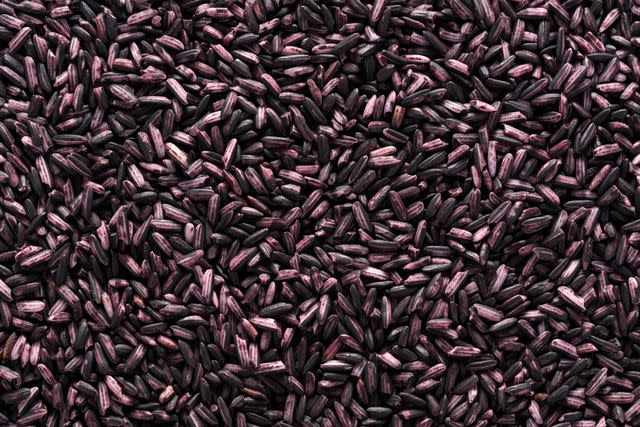
MirageC / Getty Images
Purple rice represents another variant of whole grain rice available in two distinct forms: long grain and sticky rice.
Purple rice is garnering increasing attention from both researchers and consumers alike due to its notable anthocyanin content. While research on the beneficial effects of purple rice is limited to mostly in vivo and in vitro studies, a small human study observed that consuming bread made from purple rice resulted in decreased post-meal blood sugar and insulin levels among healthy individuals compared to consuming white rice bread.
A quarter-cup serving of dry purple whole grain aromatic rice offers 140 calories, 5.98 grams of protein, 30 grams of carbs, and 1.98 grams of fiber.
5. Wild Rice
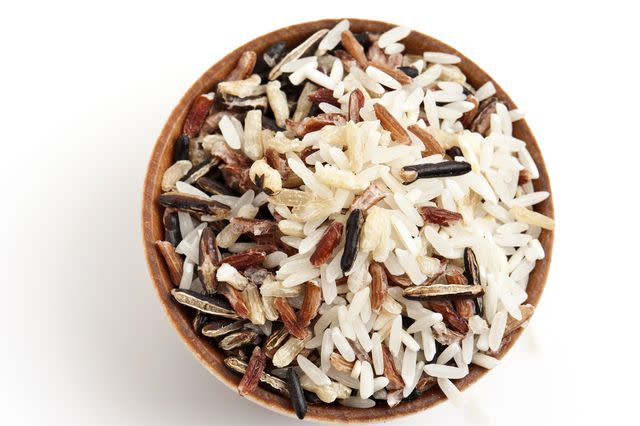
Juanmonino / Getty Images
Wild rice, despite its name, is not a true rice but rather a semi-aquatic grass native to the upper Great Lakes region, now naturally occurring across much of the United States.
Due to its challenging cultivation process and higher production costs compared to other grains, wild rice is often blended with more affordable options such as brown rice or white rice.
Wild rice is a type of whole grain and boasts high levels of antioxidants, as evidenced by a study analyzing 11 wild rice samples, which found that its antioxidant activity surpassed that of a white rice control thirty times.
One cup of cooked wild rice provides 166 calories, 6.54 grams of protein, 34.9 grams of carbs, and 2.95 grams of fiber.
6. Enriched White Rice
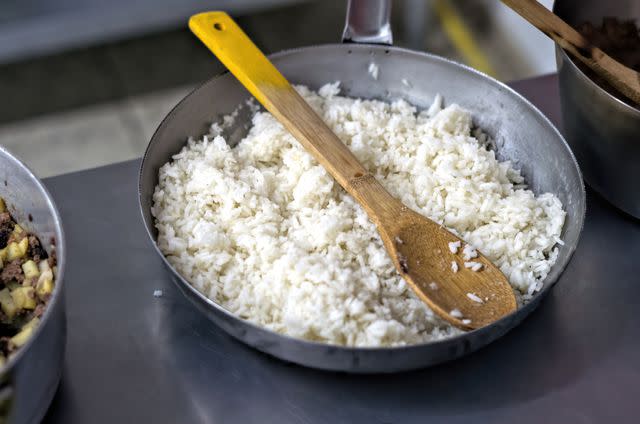
Simon McGill / Getty Images
Enriched white rice is the most consumed type of rice worldwide and accounts for a majority of the U.S. rice production. While whole grain rice such as brown rice is often heralded as a healthier option, white rice maintains its popularity due to factors like its palatability, extended shelf life, and ease of cooking.
Unlike brown rice, the germ and bran layers are removed in white rice, leaving the starchy endosperm. Although enriched rice generally contains less fiber and protein than brown rice, it's enriched with vitamins and minerals such as B vitamins and iron.
A cup of cooked, enriched, medium-grain white rice contains 242 calories, 4.43 grams of protein, 53.2 grams of carbs, 0.558 grams of fiber, 15% of the daily value (DV) for iron, 25% of the DV for selenium, 26% of the DV for thiamin, and 45% of the DV for folate.
7. Arborio Rice
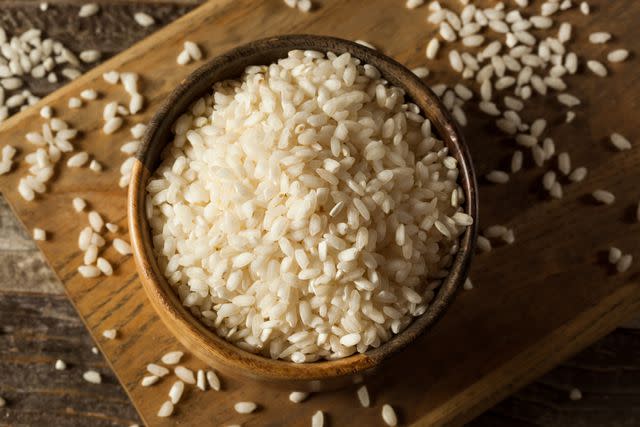
bhofack2 / Getty Images
Named after a town in Piedmont, Italy, Arborio rice distinguishes itself with its oval shape and milky white appearance. It's renowned for its high amylose (a type of starch) content. As such, Arborio rice releases a significant amount of starch during cooking, resulting in a creamy texture ideal for cooking risotto.
U.S. Arborio rice is a medium-grain rice distinguished by a distinct white dot at the center of each grain. Notably, it boasts a higher protein content compared to other medium-grain rice varieties. Arborio rice also has a great capacity to absorb flavors.
A quarter-cup serving of dry Arborio rice provides 160 calories, 3 grams of protein, 35 grams of carbs, and 0 grams of fiber.
Are Any Types of Rice Less Good for You?
Many types of rice can align with a healthy eating pattern. However, it's advisable to limit the consumption of packaged pre-seasoned rice. These products often contain high levels of sodium, artificial additives, and preservatives to enhance flavor and extend shelf life. Additionally, they may contain added sugars and unhealthy fats, potentially contributing to higher calorie intake.
Choose plain rice varieties and season them with herbs, spices, and healthy fats to allow for better control over ingredients and promote a healthier diet overall.
Can You Have Too Much Rice?
Balanced eating encompasses a diverse array of foods from various groups, not solely grains such as rice. Moderation and portion control is key when incorporating rice into a healthy diet.
Rice is a filling, calorie-dense food. Not monitoring rice portion sizes can lead to calorie overconsumption, blood sugar spikes, and nutrient imbalance.
The Dietary Guidelines advise adults to aim for a total daily grain intake of 5 to 10 ounces, with the exact amount varying based on age and gender. A one-ounce serving, equivalent to about a half-cup of cooked rice, serves as a standard measure within this recommendation.
Regarding concerns about arsenic in rice, if you're wondering about its safety, research shows that U.S.-grown rice contains the lowest levels of inorganic arsenic compared to other countries, according to a study by the World Health Organization.
While organic arsenic poses no threat, inorganic arsenic can be harmful in excessive amounts, yet it's present in various foods besides rice, including fruits, vegetables, flour, meats, and eggs. Avoiding arsenic entirely will likely lead to nutrient deficiencies, as it's found in a range of nutritious foods.
If you're still concerned about arsenic in rice, look out for parboiled or converted rice, which goes through a cooking treatment that removes 54% and 73% of inorganic arsenic for brown and white rice respectively.
Tips for Consuming Rice
Explore different types of rice, especially whole grain varieties, to diversify your diet and increase fiber intake. Here are some nutritious ways to incorporate rice into your meals:
Pair rice with lean proteins such as grilled chicken, fish, or tofu and a side salad or vegetable for a balanced meal.
Enjoy rice bowls with leafy greens, avocado, and beans.
Stir fry rice with shrimp or eggs and vegetables such as bell peppers, snap peas, and broccoli.
Assemble lettuce wraps with rice, lean ground beef, and veggies such as carrots, cucumbers, and bean sprouts.
Create a hearty soup using rice, vegetables such as carrots, onion, and celery, broth, and a lean protein.
A Quick Review
Incorporating a variety of healthy rice into your diet offers nutritional benefits. Remember, whole grain options go beyond brown rice and include pigmented varieties such as black rice as well as wild rice. Balance rice consumption with portion control and diverse meal options, such as rice bowls, stir-fries, and salads, to ensure a well-rounded diet. With mindful choices and creative culinary approaches, rice can be a delicious and nutritious staple in your healthy eating regimen.
For more Health.com news, make sure to sign up for our newsletter!
Read the original article on Health.com.

